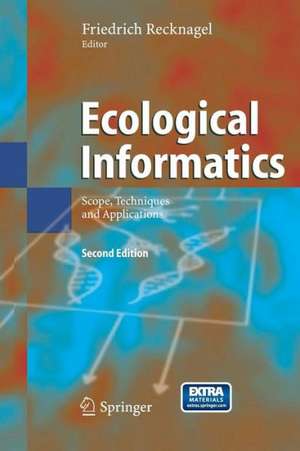Ecological Informatics: Scope, Techniques and Applications
Editat de Friedrich Recknagelen Limba Engleză Paperback – 28 noi 2014
Case studies focus on applications of artificial neural networks, evolutionary computation, cellular automata, adaptive agents, fuzzy logic as well as qualitative reasoning.
The 2nd edition of the book includes an index with novel evolutionary algorithms for the discovery of multiple nonlinear functions and rule sets as well as parameter optimisation in complex ecological data.
| Toate formatele și edițiile | Preț | Express |
|---|---|---|
| Paperback (1) | 1603.95 lei 6-8 săpt. | |
| Springer Berlin, Heidelberg – 28 noi 2014 | 1603.95 lei 6-8 săpt. | |
| Mixed media product (1) | 1370.06 lei 38-44 zile | |
| Springer – 12 feb 2006 | 1370.06 lei 38-44 zile |
Preț: 1603.95 lei
Preț vechi: 1956.03 lei
-18% Nou
Puncte Express: 2406
Preț estimativ în valută:
306.96€ • 316.67$ • 259.79£
306.96€ • 316.67$ • 259.79£
Carte tipărită la comandă
Livrare economică 05-19 martie
Preluare comenzi: 021 569.72.76
Specificații
ISBN-13: 9783642446771
ISBN-10: 3642446779
Pagini: 536
Ilustrații: XXXVI, 496 p.
Dimensiuni: 155 x 235 x 28 mm
Greutate: 0.74 kg
Ediția:2nd ed. 2006
Editura: Springer Berlin, Heidelberg
Colecția Springer
Locul publicării:Berlin, Heidelberg, Germany
ISBN-10: 3642446779
Pagini: 536
Ilustrații: XXXVI, 496 p.
Dimensiuni: 155 x 235 x 28 mm
Greutate: 0.74 kg
Ediția:2nd ed. 2006
Editura: Springer Berlin, Heidelberg
Colecția Springer
Locul publicării:Berlin, Heidelberg, Germany
Public țintă
ResearchDescriere
Ecological Informatics promotes interdisciplinary research between ecology and computer science on elucidation of principles of information processing in ecosystems, ecological sustainability by informed decision making, and bio-inspired computation. The 2nd edition of the book consolidates the scope, concepts, and techniques of this newly emerging discipline by a new preface and additional chapters on cellular automata, qualitative reasoning, hybrid evolutionary algorithms and artificial neural networks. It illustrates numerous applications of Ecological Informatics for aquatic and terrestrial ecosystems, image recognition at micro- and macro-scale as well as computer hardware design.
Case studies focus on applications of artificial neural networks, evolutionary computation, cellular automata, adaptive agents, fuzzy logic as well as qualitative reasoning.
The 2nd edition of the book includes an index with novel evolutionary algorithms for the discovery of multiple nonlinear functions and rule sets as well as parameter optimisation in complex ecological data.
Case studies focus on applications of artificial neural networks, evolutionary computation, cellular automata, adaptive agents, fuzzy logic as well as qualitative reasoning.
The 2nd edition of the book includes an index with novel evolutionary algorithms for the discovery of multiple nonlinear functions and rule sets as well as parameter optimisation in complex ecological data.
Cuprins
Ecological Applications of Fuzzy Logic.- Ecological Applications of Qualitative Reasoning.- Ecological Applications of Non-supervised Artificial Neural Networks.- Ecological Applications of Genetic Algorithms.- Ecological Applications of Evolutionary Computation.- Ecological Applications of Adaptive Agents.- Bio-Inspired Design of Computer Hardware by Self-Replicating Cellular Automata.- Prediction and Elucidation of Stream Ecosystems.- Development and Application of Predictive River Ecosystem Models Based on Classification Trees and Artificial Neural Networks.- Modelling Ecological Interrelations in Running Water Ecosystems with Artificial Neural Networks.- Non-linear Approach to Grouping, Dynamics and Organizational Informatics of Benthic Macroinvertebrate Communities in Streams by Artificial Neural Networks.- Elucidation of Hypothetical Relationships between Habitat Conditions and Macroinvertebrate Assemblages in Freshwater Streams by Artificial Neural Networks.- Prediction and Elucidation of River Ecosystems.- Prediction and Elucidation of Population Dynamics of the Blue-green Algae Microcystis aeruginosa and the Diatom Stephanodiscus hantzschii in the Nakdong River-Reservoir System (South Korea) by a Recurrent Artificial Neural Network.- An Evaluation of Methods for the Selection of Inputs for an Artificial Neural Network Based River Model.- Utility of Sensitivity Analysis by Artificial Neural Network Models to Study Patterns of Endemic Fish Species.- Prediction and Elucidation of Lake and Marine Ecosystems.- A Comparison between Neural Network Based and Multiple Regression Models for Chlorophyll-a Estimation.- Artificial Neural Network Approach to Unravel and Forecast Algal Population Dynamics of Two Lakes Different in Morphometry and Eutrophication.- Hybrid Evolutionary Algorithm for Rule Set Discovery in Time-Series Data to Forecast and Explain Algal Population Dynamics in Two Lakes Different in Morphometry and Eutrophication.- Multivariate Time Series Prediction of Marine Zooplankton by Artificial Neural Networks.- Classification of Fish Stock-Recruitment Relationships in Different Environmental Regimes by Fuzzy Logic with Bootstrap Re-sampling Approach.- Computational Assemblage of Ordinary Differential Equations for Chlorophyll-a Using a Lake Process Equation Library and Measured Data of Lake Kasumigaura.- Classification of Ecological Images at Micro and Macro Scale.- Identification of Marine Microalgae by Neural Network Analysis of Simple Descriptors of Flow Cytometric Pulse Shapes.- Age Estimation of Fish Using a Probabilistic Neural Network.- Pattern Recognition and Classification of Remotely Sensed Images by Artificial Neural Networks.
Caracteristici
The book provides numerous applications of ecological informatics to computational techniques for ecological analysis, synthesis and forecasting












